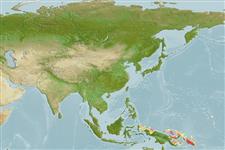>
Anguilliformes (Eels and morays) >
Congridae (Conger and garden eels) > Heterocongrinae
Etymology: Heteroconger: Greek, heteros = other + Latin, conger = conger (Ref. 45335).
More on authors: Böhlke & Randall.
Environment: milieu / climate zone / depth range / distribution range
Ecologia
marino demersale; non migratori; distribuzione batimetrica 30 - 36 m (Ref. 90102). Tropical
Western Central Pacific: Honiara, Solomon Islands and Port Moresby, Papua New Guinea.
Size / Peso / Age
Maturity: Lm ? range ? - ? cm
Max length : 40.0 cm TL maschio/sesso non determinato; (Ref. 90102)
Vertebre: 196 - 204.
Occurs in colony, on sloping sand bottom (Ref. 33408).
Life cycle and mating behavior
Maturità | Riproduzione | Deposizione | Uova | Fecundity | Larve
Kailola, P.J., 1987. The fishes of Papua New Guinea. A revised and annotated checklist. Vol. 1. Myxinidae to Synbranchidae. Research Bulletin No. 41. Department of Fisheries and Marine Resources, Port Moresby, Papua New Guinea. 194 p. (Ref. 6993)
IUCN Red List Status (Ref. 130435: Version 2024-1)
Threat to humans
Harmless
Human uses
Strumenti
Special reports
Download XML
Fonti Internet
Estimates based on models
Preferred temperature (Ref.
123201): 23 - 29, mean 28.1 °C (based on 33 cells).
Phylogenetic diversity index (Ref.
82804): PD
50 = 0.5000 [Uniqueness, from 0.5 = low to 2.0 = high].
Bayesian length-weight: a=0.00102 (0.00046 - 0.00225), b=3.06 (2.88 - 3.24), in cm total length, based on all LWR estimates for this body shape (Ref.
93245).
Trophic level (Ref.
69278): 3.3 ±0.4 se; based on size and trophs of closest relatives
Resilienza (Ref.
120179): Medio, tempo minimo di raddoppiamento della popolazione 1.4 - 4.4 anni (Preliminary K or Fecundity.).
Fishing Vulnerability (Ref.
59153): Low to moderate vulnerability (30 of 100).
